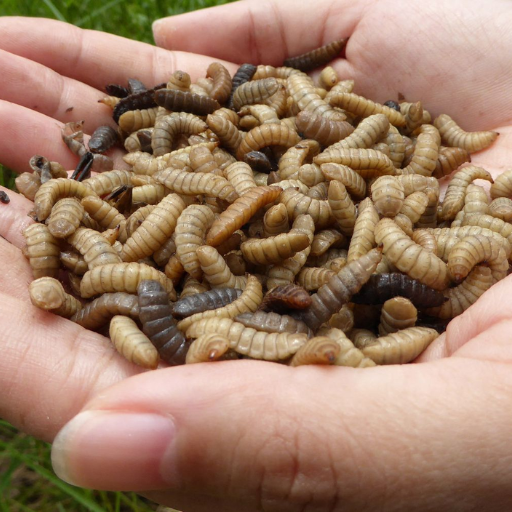To successfully store Black Soldier Fly (BSF) larvae is critical for people who want to use this novel resource in different areas, including animal feed and waste management. This article will discuss key tips and techniques that can help you store BSF larvae properly to keep them healthy and viable. We shall look at the best conditions, storage methods, and common mistakes that should be avoided, ensuring that readers are well equipped with knowledge on how they can take care of their larvae. These insights into BSF larva storage will deepen your understanding of whether you are a hobbyist or working on a large-scale production, contributing to more sustainable practices.
What are Black Soldier Fly Larvae?

Image source: https://kimmyfarm.com/
The immature stages of the Black Soldier Fly, a dark insect belonging to the family Stratiomyidae, are known as Black Soldier Fly (BSF) larvae. The BSF larvae have high protein and fat content due to their fast growth rate and efficient biomass conversion; thus, they are used widely in waste management processes, particularly for decomposing organic waste, which forms an important part of animal feed. Sustainable agriculture and eco-friendliness are among other areas where BSF Larvae have been increasingly recognized because they’re rich in all necessary nutrients.
An Introduction to Black Soldier Fly Larvae
Black Soldier Fly (BSF) larvae or Hermetia illucens provide promising solutions for waste reduction and protein production. These worms feed on organic wastes, converting them quickly into nutrient-dense biomasses. This offers effective rubbish management and creates sustainable proteins suitable for livestock industries like aquaculture farming. Furthermore, these insects contain amino acids, vitamins, and essential fatty acids, making them more attractive than conventional feeding components used by many farmers worldwide today. With increased awareness about sustainable agricultural practices such as the circular economy model where different sectors work together towards achieving common goals without depleting resources, there has been a rise in demand for alternative sources of feed like BSFL while promoting environmental friendliness at the same time within animal nutrition sectors across various regions globally.
The Lifecycle of Soldier Fly Larvae
The lifecycle of the Black Soldier Fly larvae has four distinct phases: egg, larva, pupa, and adult fly. Female BSF can lay hundreds of eggs, which will hatch from decaying organic matter in a few days. This stage is critical for about 14 to 21 days as it sees the larvae feed voraciously on organic waste while they proliferate and gain weight. They then transition into pupa after feeding when they metamorphose into pupae during the next phase, the pupal stage. This lasts for around seven to fourteen days before adult flies appear. Adult BSF do not eat but are mainly concerned with reproduction; hence, they live only for several days up to one week. The life cycle shows how efficient BSFs can manage waste, and their potential rapid growth makes them useful in sustainable agriculture practices.
Benefits of Using BSFL as Feeder Insects
Black Soldier Fly larvae (BSFL) are among the best feeder insects in a wide range of agricultural and aquacultural settings. As organic matter is converted into body mass, they have a higher feed conversion rate than other species. They are an excellent protein source for livestock and fish due to their low cost. Secondly, BSFL is nutritionally rich in terms of protein content, essential amino acids, and healthy fats, which makes them suitable as alternatives for traditional feeds. Thus, using BSFL reduces waste by recycling organic materials that would otherwise pollute the environment. Given its rapid life cycle, this insect can be produced quickly to meet the growing demand for sustainable animal feed. Finally, adding BSFL into feeding regimens improves animals’ health and growth rates, thus increasing farm productivity.
How Do You Store Black Soldier Fly Larvae?
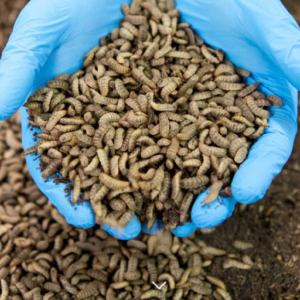
Keeping Black Soldier Fly larvae (BSFL) requires a cool and dry environment. The ideal temperature range for larvae storage is between 10°C to 15°C (50°F to 59°F). Use containers that allow airflow so moisture doesn’t build up and cause mold or rot. Use a breathable container in the fridge for longer-term storage, but ensure there’s enough space because too many can stress them out. Check on your little buddies often; if you see any that are starting to decay, take them out immediately!
The Importance of Proper Storage
Correct storage of Black Soldier Fly larvae (BSFL) is essential for longevity and nutritional value. Various sources recommend a stable, cool environment to prevent spoilage and maintain the viability of BSFL for future use. According to websites, optimal humidity levels and ventilation are key factors in storage practices. Recommended temperatures significantly reduce the risk of mold growth and decay in larvae. In addition, regularly inspecting stored BSFL can identify any issues early on, ensuring only healthy larvae are used in animal feed to maximize this sustainable protein source’s benefits.
Best Containers for Storing BSFL
When storing Black Soldier Fly larvae (BSFL), container choice plays a pivotal role in maintaining healthiness and lifespan. Here are the top recommendations from leading sites:
- Ventilated Plastic Containers: Many sources indicate that ventilated plastic containers with plenty of ventilation holes should be used. This helps regulate airflow while reducing humidity, thus decreasing the chances of mold growth—food storage containers or terrariums work well here.
- Cardboard Boxes: Another popular option includes reinforced cardboard boxes because they’re lightweight & easy-to-transport yet still provide breathable environments as long as there’s proper air circulation through vents so moisture doesn’t build up inside too much over time due to lack thereof
-
Glass Jars or Aquariums: For smaller quantities, glass jars or aquariums may prove efficient since they offer visibility into what’s going on with our little friends, and breathable lids keep humidity appropriate without suffocating anyone involved. Remember, though, that cleanliness goes hand in hand when dealing with living creatures!
Regardless of the container chosen, ensure it is clean and dry, and regularly inspect the larvae to keep them healthy and robust.
Refrigeration vs. Room Temperature
For the health of Black Soldier Fly larvae (BSFL), it is important to understand the effects of refrigeration instead of room temperature when storing them. The metabolism of BSFL slows down, and their risk of mold and decay decreases with this method, which is recommended for more extended storage periods to maintain nutritional quality. Most expert sources agree that refrigeration can significantly extend lifespan.
On the other hand, if they are meant for immediate use or feeding, keeping BSFL at room temperature may cause more active larvae, but ensuring proper ventilation and humidity levels is vital in such a case so as not to spoil them. Ideally, short-term storage should be monitored closely, while refrigeration is better suited for longer durations since it ensures the larvae remain healthy and viable for feeding.
How Can You Extend the Lifespan of Black Soldier Fly Larvae?
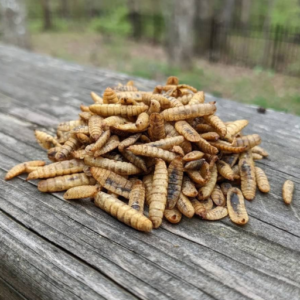
The lifespan of Black Soldier Fly larvae (BSFL) can be extended by implementing a few key practices. The first practice is to maintain the ideal temperature. One can extend their life in storage for longer periods if they put them in the refrigerator, which slows down their metabolism. The second thing that should be done is ensuring cleanliness and hygiene, which can be achieved by frequently changing bedding materials and washing containers; this will stop harmful bacteria and mold from growing. Furthermore, controlling humidity levels while allowing good ventilation prevents moisture buildup that may result in rotten BSFLs. Lastly, offering a balanced diet with adequate nutrients improves the overall health of the larvae, hence making them live longer. With these practices, you’ll have successfully increased BSFL’s lifetime, making it better suited for use in different ways.
Optimal Temperature for Prolonged Storage
The recommended storage temperature for Black Soldier Fly larvae (BSFL) is between 4°C and 10°C. This metabolically slows them down, allowing for extended life during storage. These temperatures also maintain a higher nutritional value of BSFL while preventing spoilage. These fluctuations should be observed constantly since too much cold or changing conditions would harm their health. Also, there must be enough ventilation in the place where they are kept so as not to dry out completely but still provide some moisture control, allowing these insects to live longer.
Humidity and Moisture Control
Effective humidity and moisture management is a must to store Black Soldier Fly larvae (BSFL). The most common range for humidity levels is between 50% and 70%. If the humidity exceeds this range, mold will grow on the BSFL, leading to decay. You should regularly use hygrometers to check for ideal conditions in your storage space. You can lower moisture levels using dehumidifiers or silica gel packets as they absorb excess water from the air around them when needed. Also important are air circulation systems that prevent pockets of still air where humidity might build up due to lack of movement through it. Managing these factors can greatly increase the health and viability of BSFL, thus prolonging their life span for different uses.
Feeding and Nutritional Needs
To properly feed Black Soldier Fly larvae (BSFL), you need organic matter-rich diet items such as food waste, agricultural by-products, animal manure, etc.; They can potentially convert these materials into high-quality protein fats suitable for animal feeds; hence, it is best practice to provide balanced diets containing carbohydrates, proteins, essential vitamins, and minerals, among others, promoting optimal growth. Proper Feeding practices involve consistent supply but not overfeeding because this leads to poor quality larvae with undesirable waste accumulation; therefore, regular evaluation should be done on growth development patterns exhibited by the larvae so that appropriate adjustments can be made concerning feeding strategies employed during different stages of the development process.
How to Prepare Black Soldier Fly Larvae for Feeding?
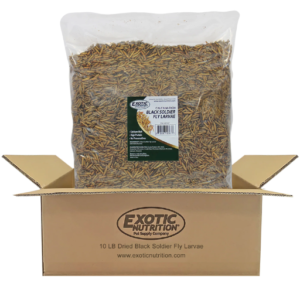
Start by collecting Black Soldier Fly larvae (BSFL) at the right developmental stage, usually just before they pupate. Gently rinse them in clean water to remove any debris or waste material. After washing, blanch the larvae in boiling water for a few minutes to kill and stop any possible pathogens rapidly. Let the larvae cool down and drain off all excess moisture from them completely. Store prepared BSFLs in airtight containers inside the fridge or freezer as necessary for freshness preservation. When you are ready to use them, BSFL can be given as nutritious feedstuff for poultry, fish, or other livestock.
Gut-Loading Your BSFL
Gut-loading involves feeding nutrient-rich diets to black soldier fly larvae (BSFL) just before harvesting to improve their nutritional value. The process increases the larvae’s protein levels, vitamins, and minerals, which eventually benefits animals that consume it. For effective gut loading of BSFL use high-quality feeds formulated with balanced carbohydrates and proteins like fruits, vegetable grains, etc.; it is advisable to start gut loading not less than 24 hours prior until up-to48hours before harvesting, ensuring a constant supply of fresh food coupled with clean drinking water throughout this period where close monitoring will allow modifications on feed mix thus enhancing healthiness while increasing overall nutrition density during harvest time.
Dusting with Calcium and Vitamins
Dusting them with calcium and vitamins is an effective way to enhance the nutritional profile of Black Soldier Fly larvae (BSFL) before offering them as feed. To do this, you should first pick a good quality calcium supplement like calcium carbonate or calcium citrate and balanced vitamin powder that contains essential vitamins such as A, D3, and E. After ensuring the larvae are clean and dry, place them in a container together with the dust made from these supplements then shake gently for even coating. This process helps poultry’s bone health by improving their calcium-to-phosphorus ratio and provides necessary vitamins that boost overall health and immunity. Periodically dusting BSFL can result in more robust animals with higher growth rates, thus increasing productivity.
Signs of Healthy vs. Unhealthy Larvae
Determining whether Black Soldier Fly larvae (BSFL) are healthy is important since this influences feed quality greatly. Healthy larvae usually have plump bodies, feel firm when touched, and appear shiny without any discoloration at all on their bodies while showing some level of active movements around their environment. On the other hand, unhealthy ones may look shriveled up or pallid, showing brownish/black coloration coupled with sluggishness, among other signs such as a bad smell caused by a rotting/decomposed state, indicating an unfit condition for feeding. Regular checkups will guarantee proper nourishment besides raising yield levels in livestock fed using these products.
Common Issues When Storing Black Soldier Fly Larvae and How to Prevent Them
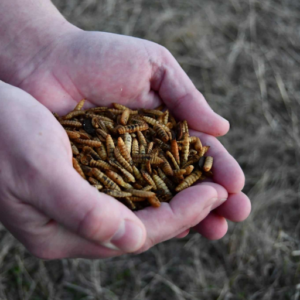
Moisture retention is one of the main problems with storing Black Soldier Fly larvae (BSFL), which can result in spoilage or mold growth. Place them in a ventilated container and control the humidity to avoid this. Also, temperature changes can negatively impact their health, so keeping the temperature steady is important. Overcrowding can also stress out the larvae, leading to unhealthy conditions; therefore, containers should be used big enough for them to have space and airflow. Regular checks on the storage conditions and health of BSFL will help ensure they are still fit for feeding.
Preventing Larvae from Pupating
You must control their environment to stop black soldier fly larvae (BSFL) from becoming pupae. Lowering the temperature at which these organisms live between 20-25°C (68-77°F) slows down its development into maturity stage where it becomes pupa.. A constant supply of food, especially protein-rich diets, should be provided to make them grow instead of changing into immature insects known as pupae. It’s also important not to expose BSFL to light because darkness prevents conversion into pupal stages too frequently. In contrast, regular collection and separation of nearly matured ones decreases the chances of unwanted mutations, thus ensuring continuous availability throughout different periods when they are needed most by humans who feed on such creatures as chicken eggs, among others.
Managing Mold and Bacterial Growth
The most important factors for effectively controlling mold and bacteria growth in storage for Black Soldier Fly larvae (BSFL) are cleanliness and environmental management. To reduce contamination risks, cleaning storage containers regularly and disinfecting them is critical. Using breathable, well-aerated containers can help prevent moisture buildup and promote air circulation, essential in preventing mold from forming. Furthermore, adding probiotics or safe organic antimicrobial agents may increase the resilience of BSFL against harmful bacteria and fungi. Lastly, monitoring food quality by ensuring that all feed supplied is fresh will reduce the chances of microbial issues within the storage environment.
Avoiding Overcrowding in Containers
Preventing overcrowding when raising BSF larvae requires proper partitioning among containers where each larva has enough space for growth. A common rule of thumb suggests maintaining a density between 1 – 2 thousand per square foot, allowing movement without competition over feeding resources. Regularly checking population size and then adjusting number/type depending on whether there are too many should be done to ensure no other signs indicating this problem arise, such as lack of space due to increased container volume needed, which results from frequent harvesting mature individuals thus keeping numbers manageable within any given region/division(s). Also, larger units could be used instead. Still, they must not necessarily be divided since different sizes might cause stress among conspecifics, thereby affecting health status/productivity levels negatively, henceforth influencing overall welfare outcomes positively instead vice versa if poorly managed throughout their life cycle stages until maturity occurs later on during developmental process(es).
Frequently Asked Questions (FAQs)
Q: What should I do when my black soldier fly larvae arrive?
A: When the larvae of the black soldier fly arrive, typically in a small plastic cup, you should first transfer them to a larger container with proper substrate, such as wheat bran or coconut coir. This allows them more space to move and grow.
Q: How long can I store black soldier fly larvae in the fridge?
A: Black soldier fly larvae can be stored in the refrigerator, ideally at a temperature around 50-55 degrees Fahrenheit, for up to 2 weeks. This slows down their metabolism and prolongs their lifespan without the need to feed or gut-load them.
Q: Do I need to feed or gut-load my BSFL unless they’re getting too small?
A: It’s generally recommended to gut-load your BSFL unless they’re getting too small, especially if you’re using them as feed for your reptile or amphibian pets. Providing them with nutritious food like fresh fruits or specialized gut-load products ensures they provide the best nutrition to your pet.
Q: Can black soldier fly larvae be used to feed my pets?
A: Yes, black soldier fly larvae, often called nutrigrubs, are high in calcium and protein, making them one of the best feeder insects for reptiles, amphibians, chickens, and other pets. They’re a nutritious alternative to traditional mealworms or crickets.
Q: How do I prevent my black soldier fly larvae from turning into flies?
A: Store the larvae in the refrigerator or a cooler at 50-55 degrees Fahrenheit to prevent them from turning into flies. This temperature range slows their development significantly.
Q: What substrate should I use for my black soldier fly larvae?
A: Suitable substrates include wheat bran, coconut coir, or other organic material. The substrate keeps them comfortable and offers an additional nutrient source if you need to feed or gut-load your BSFL.
Q: How do I transfer my black soldier fly larvae into a new container?
A: Gently pour the larvae from their tiny plastic cup into a new container filled with an appropriate substrate. Ensure the container is ventilated but secure to prevent escapes. An ideal container is a plastic or glass container with a fitted lid.
Q: Can I keep black soldier fly larvae at room temperature?
A: You can keep black soldier fly larvae at room temperature, but they’ll develop faster. If you don’t need to use them immediately, storing them in a more relaxed environment to extend their shelf life is better.
Q: What should I do if my black soldier fly larvae start to smell?
A: An unpleasant odor usually indicates that the substrate is too moist or that organic matter has built up. To prevent bad smells, replace the substrate with fresh bedding and ensure the container is clean and dry.
Q: Where can I buy high-quality black soldier fly larvae?
A: High-quality black soldier fly larvae can be purchased from reliable suppliers like dubiaroaches.com. Choose a reputable source to guarantee the larvae’s health and nutritional value.













